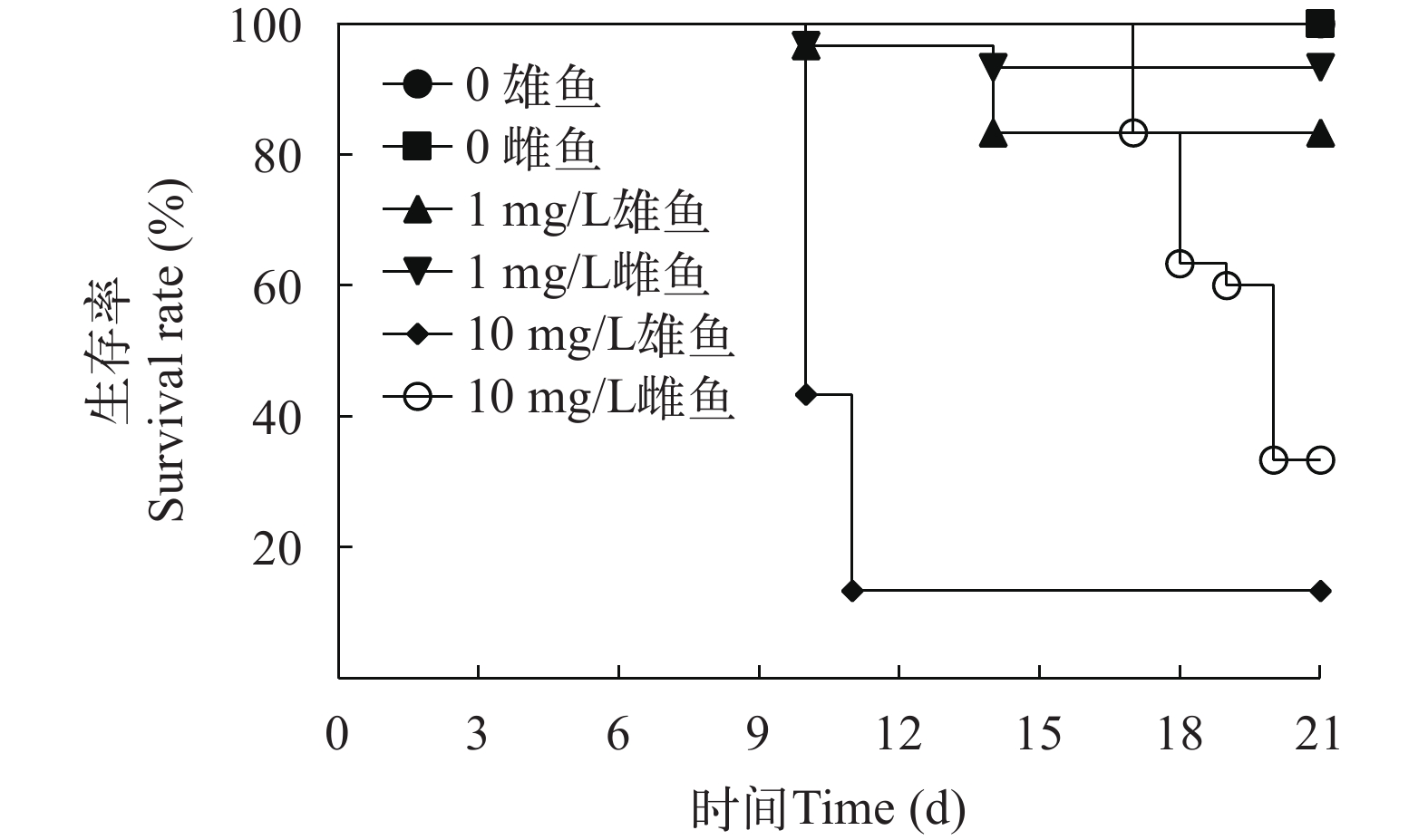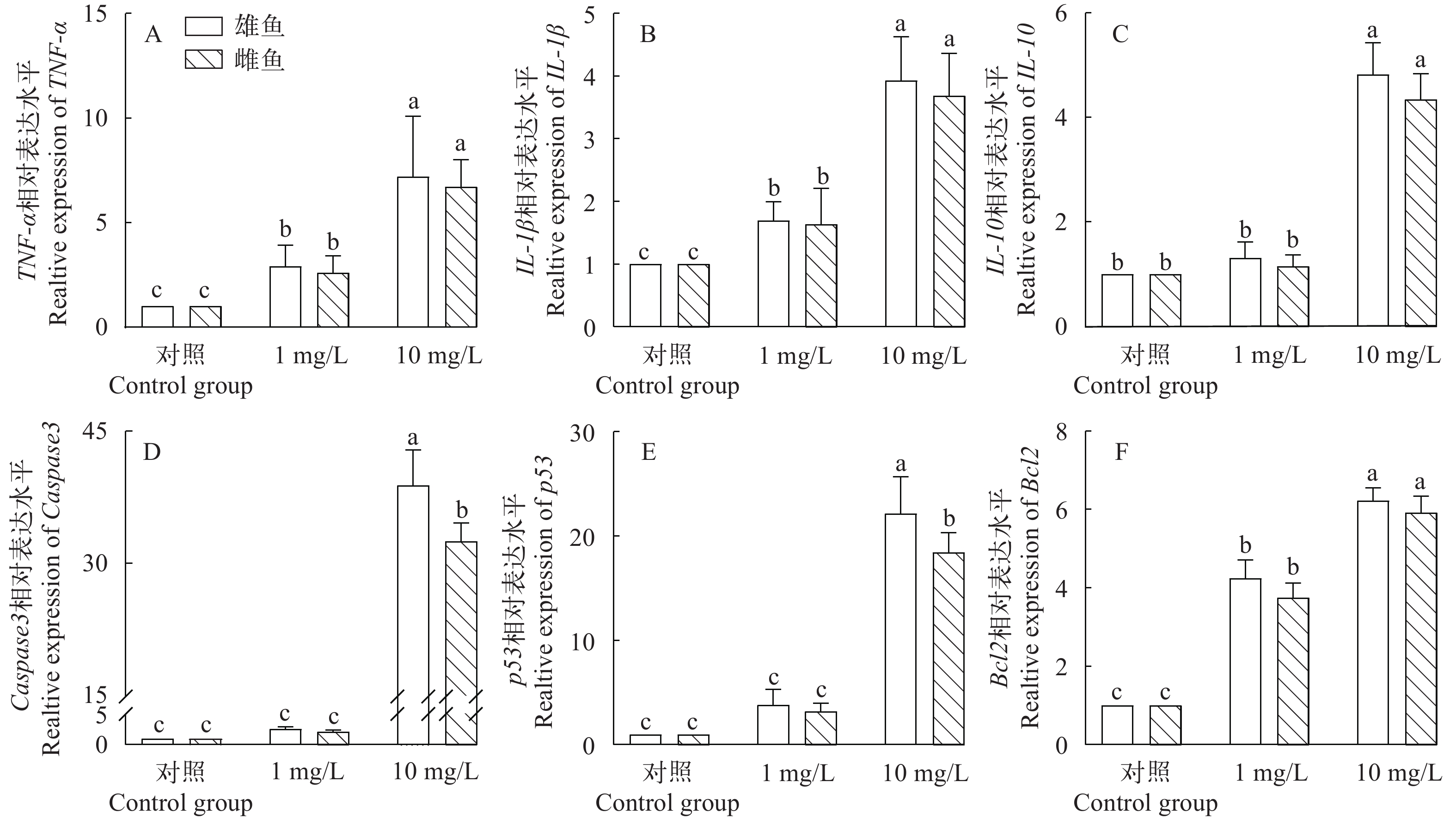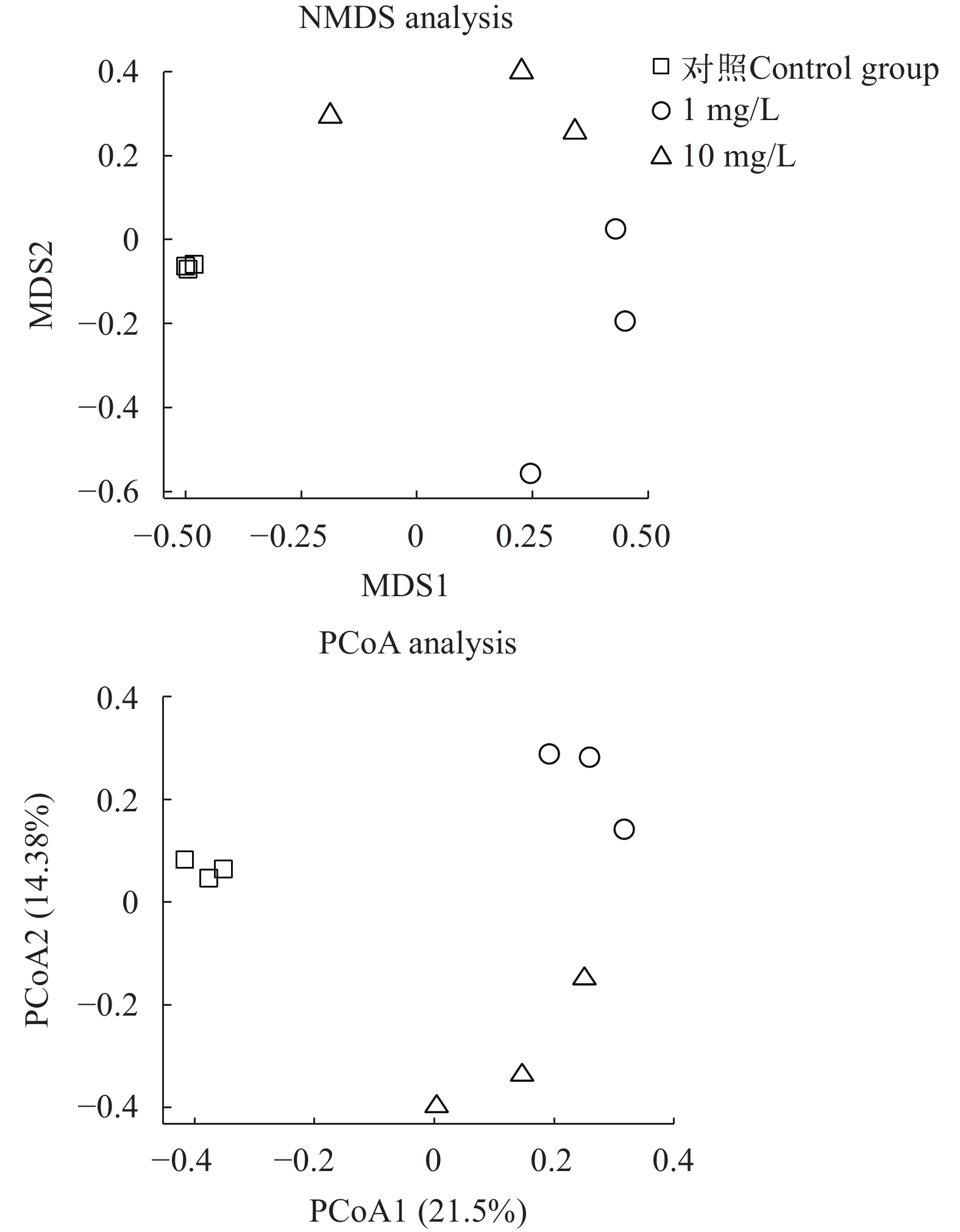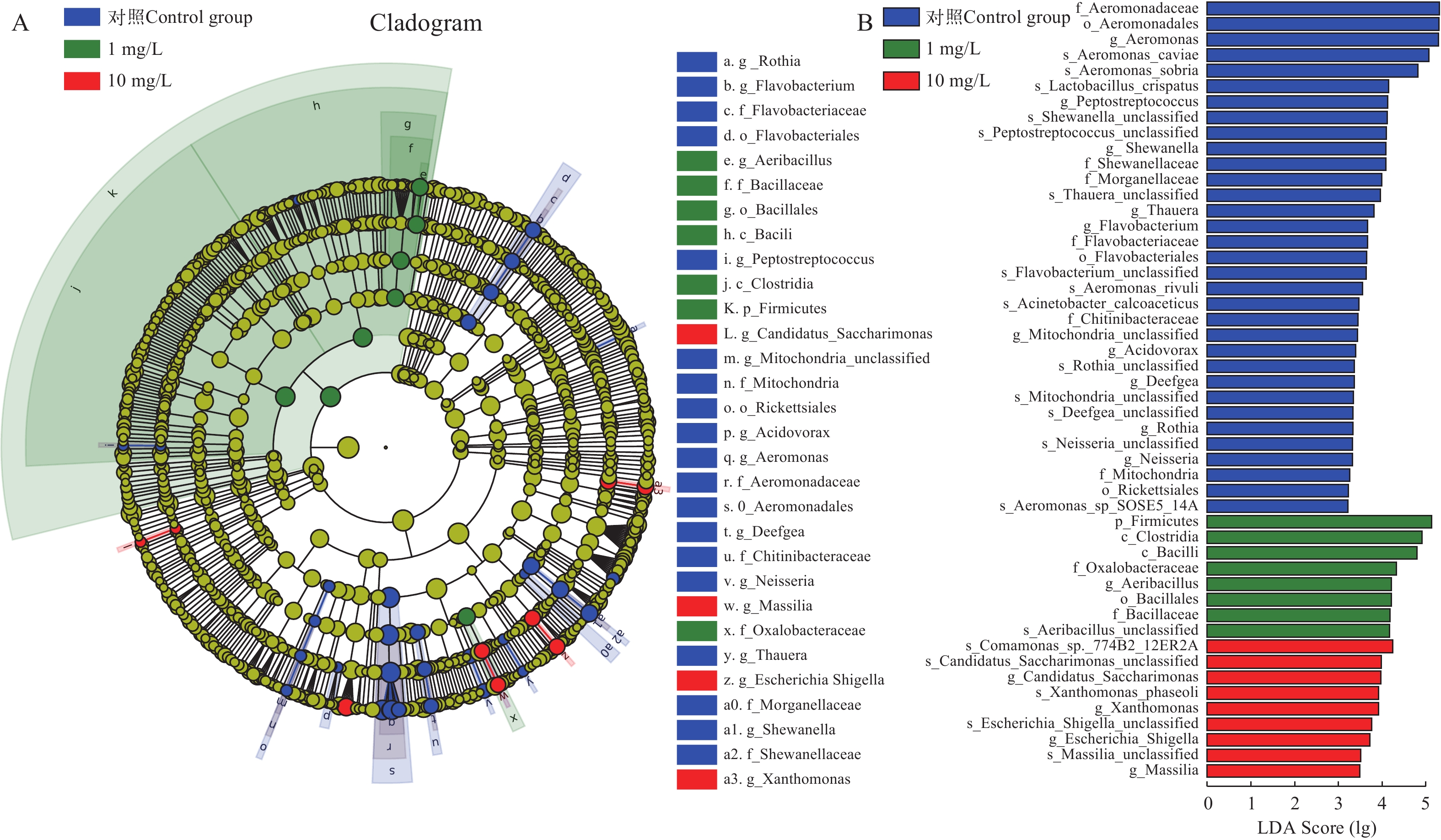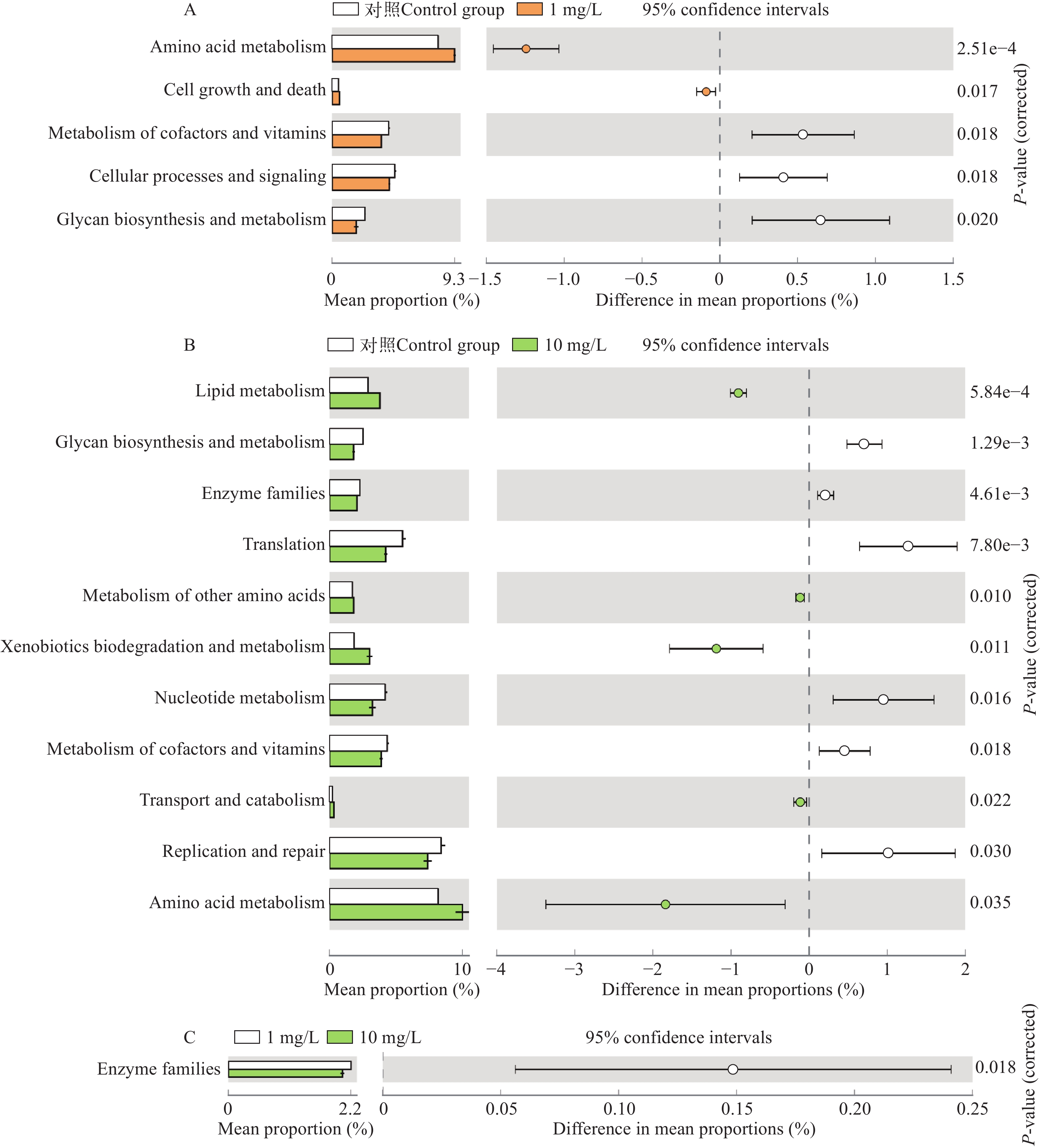PERFLUOROOCTANE SULFONATE (PFOS) ON INTESTINAL STRUCTURE AND MICROBIOTA OF ZEBRAFISH (DANIO RERIO)
-
摘要:
为探究全氟辛烷磺酸(Perfluorooctane sulfonate, PFOS)对鱼类的肠道毒性, 将雌雄斑马鱼分别暴露于0、1和10 mg/L的 PFOS中21d, 通过存活率、肠道组织切片、16S rRNA高通量测序、实时荧光定量PCR等技术检测斑马鱼肠道形态结构及微生物菌群的变化。结果表明: 暴露于10 mg/L PFOS的斑马鱼死亡率明显高于1 mg/L, 且对雄鱼的影响大于雌鱼。1 mg/L浓度组雌雄鱼的存活率分别为93.3%和83.3%, 而10 mg/L为33.3%和13.3%。1 mg/L PFOS暴露使斑马鱼的肠壁厚度轻微变薄、肠绒毛有破损的现象。10 mg/L浓度组肠壁厚度明显变薄, 肠绒毛高度降低、肠黏膜上皮细胞肿胀并伴随严重的溶解现象。PFOS暴露21d后, 肠道组织的炎症相关基因肿瘤坏死因子α (TNF-α)、白介素1β (IL-1β)和白介素10 (IL-10), 以及细胞凋亡相关基因胱天蛋白酶3 (Caspase 3)、p53、B淋巴细胞瘤-2 (Bcl2) 的表达量均显著高于对照组, 且Caspase3和p53基因在雄鱼的肠道的表达量显著高于雌鱼(P<0.05)。PFOS暴露显著增加了肠道菌群的多样性, 改变了肠道菌群结构。厚壁菌门(Firmicutes)、变形菌门(Proteobacteria)、放线菌门 (Actinobacteriota)和拟杆菌门(Bacteroidota)的相对丰度均显著增加, 而梭杆菌门(Fusobacteria)显著下降。在属水平, PFOS处理增加了罗尔斯通菌属(Ralstonia)和假单胞菌属(Pseudomonas)相对丰度, 而降低鲸杆菌属(Cetobacterium) 和气单胞菌属(Aeromonas)。两个处理组肠道菌中厚壁菌门/拟杆菌门(F/B)的比值高于对照组。PFOS处理增强了肠道菌群的氨基酸及脂代谢功能, 但削弱了聚糖的合成与代谢能力。综上所述, PFOS长期暴露会引起水生动物的肠道结构损伤及微生物菌群失调, 进而影响动物的健康。
-
关键词:
- 全氟辛烷磺酸(PFOS) /
- 肠道结构 /
- 微生物菌群 /
- 斑马鱼
Abstract:Perfluorooctane sulfonate (PFOS), as the main active component in anti-fouling agents used for textile and leather products, has been widely used in both industrial and daily settings. So far, PFOS contamination has been detected in groundwater, surface water, seawater, and even animal tissues. It exhibits notable toxicity to the liver, reproduction, development, and nervous system of fish; however, the effect on the fish intestine remain unclear. In this study, male and female zebrafish were exposed to 0, 1, and 10 mg/L of PFOS for 21d, respectively, and the changes in intestinal morphology, structure, and microflora of zebrafish were detected by survival rate, intestinal tissue section, 16S rRNA high-throughput sequencing, Real-time quantitative PCR, and other techniques. The results showed that zebrafish exposed to 10 mg/L PFOS had a significantly higher mortality rate than those exposed to 1 mg/L, with males being more affected than females. The survival rates of male and female fish in the 1 mg/L concentration group were 93.3% and 83.3%, while those in the 10 mg/L concentration group were 33.3% and 13.3%, respectively. Exposure to 1 mg/L PFOS led to a reduction in intestinal thickness and damage to intestinal villi. In the 10 mg/L group, the intestine was significantly thinner, villi height was reduced, and intestinal mucosal epithelial cells were swollen and accompanied by severe dissolution. After 21d PFOS exposure, the inflammation-related genes such as tumour necrosis factor-alpha (TNF-α), interleukin1beta (IL-1β), and interleukin10 (IL-10), along with caspase3, p53, and B-cell lymphoma-2 (Bcl2), were significantly higher than those of the control group. Furthermore, caspase3 and p53 expression in male intestines was significantly higher than those in females (P<0.05). PFOS exposure also significantly increased the diversity and altered the structure of gut microbiota, with a marked rise in the relative abundance of Firmicutes, Proteobacteria, Actinobacteriota, and Bacteroidota, and a significant decline in Fusobacteria. At the genus level, PFOS treatment increased the relative abundance of Ralstonia and Pseudomonas, but decreased Cetobacterium and Aeromonas. The Firmicutes/Bacteroidetes (F/B) ratio was higher in both treatment groups compared to the control group. Additionally, PFOS treatment increased the amino acid and lipid metabolism of the gut flora, but decreased the synthesis and metabolism of glycans. In conclusion, long-term PFOS exposure can lead to structure damage to the intestinal and dysbiosis in the microbial flora of aquatic animals, subsequently affecting their health.
-
Keywords:
- PFOS /
- Intestinal structure /
- Intestinal microbiota /
- Danio rerio
-
全氟辛烷磺酸(Perfluorooctane sulfonate, PFOS, C8HF17O3S)是全氟化合物(Perfluoroalkyl substances, PFASs) 中典型的持续性有机污染物, 于1950年开始被应用于表面活性剂、润滑剂、农药等工业生产和生活消费领域[1], 是易存留于环境中的高毒性人工合成非天然工业原料。水环境中的检出率从ng/L到μg/L, 甚至在高污染地区可以达到mg/L[2]。2006年在德国鲁尔河流域的水质监测中PFOS的检测含量最高达到4.385 mg/L[3]。PFOS可沿食物链在生物体内富集[4], 美国北卡罗来纳州健康动物血液中检测到PFOS为1.4—34.6 μg/L, 且在动物组织富集程度为肝脏>肌肉>肾脏[5]。因此, 2006年12月欧洲发布了《关于限制全氟辛烷磺酸销售及使用的指令》。美国新泽西州限定地表水中PFOS含量低于13 ng/L, 加拿大限定为600 ng/L[5]。我国一批学者对不同水体环境进行了PFOS污染物污染程度的调查。太湖中2001年PFOS的平均含量为3.53 ng/L[6]。2017年, 上海黄浦江中PFOS的平均检出量为46.5 ng/L[7]。2018年PFOS被我国正式列入《中国严格限制的有毒化学品名录》, 但污泥和地表水中仍有PFOS不断检出[8], 2022年四川省沱江中全氟化合物检出的浓度最高点为3.789 mg/L, 其中PFOS在沱江流域采样点的检出率为100%, PFOS检出量最高达到1.764 mg/L[9]。
PFOS难降解性导致其在动物体内大量富集[10]。不同地区的海洋和淡水生物的肝组织PFOS富集浓度为5—9031 ng/g[11], 人类血清中清除PFOS的半衰期需要5.4年[12]。因此, 目前的研究多集中在富集浓度的危害方面[13]。浓度0.32 和3.2 mg/L PFOS暴露会导致斑马鱼幼鱼发育过程中畸形率增加和生长受阻[13]。1 mg/L PFOS处理导致斑马鱼胚胎发育过程心脏缺陷[14]。生物毒性测定PFOS的半数致死浓度值LC50 (96h)为75.864 mg/L[15]。因此不同富集浓度引起的损伤有明显组织差异。PFOS富集会引起机体异常增重、个体体重减小、基因突变、线粒体损伤等问题[16]。肠道是直接接触PFOS污染物的重要组织, 而肠道菌群结构会影响机体的各项生理功能[17], 因此, PFOS长期暴露对水生动物的肠道毒性研究有利于为其富集危害评估提供依据。
斑马鱼是国际标准化组织(ISO) 推荐使用的鱼类毒性模型动物, 被广泛应用于毒理学、环境保护、发育生物学等研究[18]。斑马鱼的基因与人类的基因高度相似, 且斑马鱼和哺乳动物之间在肠道多个代谢功能与免疫功能上也是高度保守的, 是研究肠道损伤和毒害作用的理想模式生物[19]。
鉴于水生系统中环境污染物的复杂性及PFOS的持久性和生物累积性, 本试验以模式动物斑马鱼为研究对象, 检测PFOS长期暴露对斑马鱼存活率、肠道微生物菌群组成和肠道结构的影响, 探索其在水生动物体内富集后潜在的长期危险性。
1. 材料与方法
1.1 试验动物及试剂
试验所用斑马鱼购自中国科学院水生生物研究所国家斑马鱼资源中心。在正式毒性暴露前, 将斑马鱼(4—5月龄)暂养在(24±1)℃循环水系统中14d, 光暗周期为14h﹕10h, 循环水为充分曝气并过滤脱氯的自来水, 水质参数: pH为7.0—7.5, 溶解氧浓度为 (6.9±0.5) mg/L, 电导率为(0.256±0.005) mS/cm, 水的硬度为 (185±9) mg/L (以CaCO3计)。在此期间, 斑马鱼每天定时以体重3%的斑马鱼专用饲料饲喂2次。本研究已通过西北农林科技大学实验动物伦理委员会审核。PFOS (CAS: 1763-23-1, 纯度>98%)购自上海鑫凯化学科技有限公司, 溶解于二甲基亚砜中, 制备成1000 mg/L的母液以备后续使用。
1.2 PFOS暴露试验
将暂养2周后的斑马鱼随机分为3组, 每个组设置3个重复。每个试验缸养殖水体积为34 L, 缸中间用网隔开, 分别放养雌雄鱼各30条。其中两组分别配置成浓度为1和10 mg/L的试验用水, 未添加组为对照组。暴露期间试验用水每2天更换1/2, 保持PFOS浓度维持在恒定水平, 其他饲料条件与暂养期一致。
1.3 存活率统计
在为期21d的暴露试验中, 每隔24h记录1次试验斑马鱼的死亡数, 用于统计斑马鱼的最终存活率。
1.4 斑马鱼肠道组织采集
在暴露21d后进行组织采集, 采样前24h停止投喂饵料。从每个处理随机采集3尾鱼, 使用 MS-222 麻醉剂将鱼麻醉后在无菌条件下采集肠道组织和肠道内容物。首先, 用0.9%生理盐水冲洗肠道来收集肠道内容物, 置于1.5 mL无菌离心管中, 冷冻保存在−80℃用于后期16S rRNA测序。然后, 剪取肠道前中段, 将一部分置于4%多聚甲醛中固定用于肠道组织切片, 其余部分放入1.5 mL无菌离心管中后迅速液氮冷冻, 保存在–80℃用于后续定量分析。每个处理组的采集样本各取3个重复。
1.5 肠组织切片
将固定在4%多聚甲醛的肠道组织用乙醇梯度脱水, 然后用100%二甲苯和无水乙醇浸泡至透明状态, 再对透明组织进行浸蜡包埋、石蜡切片、HE染色后封片保存, 最后在生物显微镜下利用Shineso F310 (Shineso, 中国)软件系统对切片进行观察测量。
1.6 实时荧光定量PCR检测肠道炎症、凋亡相关基因表达量变化
按照TRIzol法提取肠道组织总RNA并使用超微量核酸分析仪测定总RNA浓度和纯度。将RNA用反转录试剂盒 (赛默飞世尔科技中国有限公司) 反转录为cDNA。从美国国家生物技术信息中心 (NCBI)数据库检索斑马鱼的肿瘤坏死因子α (TNF-α)、白介素1β (IL-1β) 和白介素10 (IL-10) 炎症相关基因和胱天蛋白酶3 (Caspase 3)、p53、B淋巴细胞瘤-2 (Bcl2) 等凋亡相关基因序列, 利用NCBI的引物设计软件进行定量引物设计, rps11和β-actin基因作为内参基因, 引物由北京擎科生物科技有限公司合成 (表 1)。PCR反应体系 (12.5 μL): 6.25 μL 2×Taq PCR PreMix, 1 μL cDNA模板, 0.5 μL Forward Primer, 0.5 μL Reverse Primer, 4.25 μL Nuclease-free H2O。实时荧光定量PCR反应程序: 95℃预变性10min, 95℃ 30s, 60℃ 30s, 72℃ 45s共30个循环, 72℃ 延伸5min。每个样品重复3次, 反应在CFX Connect TM 实时 PCR 检测系统(Bio-Rad Laboratories, 中国)中进行。利用2–ΔΔCt算法计算相对表达量。
表 1 试验中所用引物Table 1. Primers used in this study引物名称
Primer name引物序列
Primer sequences (5′—3′)用途
Usagerps11 ACAGAAATGCCCCTTCACTG 内参基因 GCCTCTTCTCAAAACGGTTG β-actin ATGGGCGTCCATGACCTTTT 内参基因 TGTACAGAGACACCCTGGCT TNF-α AGGAGAGTTGCCTTTACCGC qRT-PCR TGGCAGCCTTGGAAGTGAAA IL-1β AACGTCATCCAAGAGCGTGA qRT-PCR ACAGGCTGAGCAGAAGTAGC IL-10 CTCACGCTTCTTCTTTGCGAC qRT-PCR TCGTTCATGACGTGACATCCA Caspase 3 TCGGTTCTCGCTGTTGAAGG qRT-PCR ACCGCTTAACGAGCCCTTTT P53 AACCCAAATTCTGCGCAACG qRT-PCR ATCCAGTTTTCCAGTGGCCC Bcl2 CCTGGCGAACATTTGGAGGG qRT-PCR GCAACGTCCACCACCATTTG 1.7 肠道微生物16S rRNA高通量测序
将1.4中收集的肠道组织样品送至杭州联川生物技术股份有限公司进行细菌16S rRNA V3—V4区微生物群落扩增子测序分析。所有数据在MajorBio云平台的进行分析。原始读数由Trimomatic进行质量过滤, 并使用FLASH合并。Uparse对具有97%相似性的操作分类单元(OTU) 进行聚类, 并去除嵌合序列。使用R语言在OTU一级进行主坐标分析(PCoA) 和非度量多维尺度分析(NMDS)。使用Qiime软件计算Shannon和Simpson多样性指数来评估Alpha多样性。使用RDP分类器对OTUs进行物种分类分析, 获得分类学信息并分别在门(Phylum)、属(Genus) 水平统计群落组成, 使用LEfSe (LDA Effect Size)分析PFOS作用下核心菌群的变化。使用PICRUSt2基于OTU数据对微生物的功能进行预测。
1.8 统计分析
所有数据均以平均值±标准差(Standard Deviation, SD) 的形式呈现, 用单因素方差分析(ANOVA)和Tukey多重比较分析统计组间差异, P<0.05为具有显著差异, P<0.01为极显著差异。使用Graphpad Prism软件对试验数据进行分析和作图。
2. 结果
2.1 斑马鱼的存活率检测
经过21d暴露, 雌雄斑马鱼的存活率存在明显差异。1 mg/L PFOS浓度组雄鱼存活率为83.3%, 而雌鱼为93.3%; 10 mg/L浓度组雄鱼存活率为13.3%, 雌鱼为33.3%。10 mg/L PFOS暴露对斑马鱼的致死率远高于1 mg/L。从图 1可以看出, 10 mg/L PFOS处理的雄鱼从第10天开始大量死亡, 而雌鱼从第17天开始出现死亡。1 mg/L组雌雄鱼均从第10天开始出现死亡现象。这表明雌雄鱼对PFOS暴露的耐受程度不同。
2.2 斑马鱼肠道组织观察
与对照组相比, 1 mg/L浓度组斑马鱼的肠道壁厚度变薄, 肠绒毛轻微破损, 雄鱼绒毛破损更严重; 而10 mg/L浓度组肠壁厚度明显变薄, 肠壁外纵肌部位和肠绒毛内部出现较多空泡化结构, 雄鱼相较于雌鱼空泡化结构更为明显, 并且肠绒毛和肠黏膜上皮细胞出现糜烂, 肿胀、溶解等现象(图 2)。
![]() 图 2 PFOS暴露对斑马鱼肠道显微结构的影响黑色箭头标注的为肠壁; 灰色箭头标注的为肠道出现空泡化现象; 白色箭头标注的为肠绒毛出现破损现象Figure 2. Effects of PFOS on intestinal microstructure in zebrafishThe black arrow indicates the intestinal wall; The gray arrow indicates the presence of vacuolation in the intestine; The white arrow indicates damage to the villi of intestine
图 2 PFOS暴露对斑马鱼肠道显微结构的影响黑色箭头标注的为肠壁; 灰色箭头标注的为肠道出现空泡化现象; 白色箭头标注的为肠绒毛出现破损现象Figure 2. Effects of PFOS on intestinal microstructure in zebrafishThe black arrow indicates the intestinal wall; The gray arrow indicates the presence of vacuolation in the intestine; The white arrow indicates damage to the villi of intestine2.3 荧光定量PCR检测斑马鱼肠道组织炎症、凋亡等相关基因的表达
PFOS暴露上调了斑马鱼肠道炎症和凋亡相关基因的表达量。从图 3A—C可以看出, 10 mg/L PFOS暴露显著提高了肠道组织TNF-α、IL-1β和IL-10 (P<0.05)基因的表达水平, 而IL-10基因在1 mg/L浓度组虽有上调趋势, 但与对照组相比无显著差异(P>0.05)。10 mg/L PFOS浓度组TNF-α、IL-1β和IL-10基因的表达量均显著高于1 mg/L浓度组(P<0.05)。在2个浓度暴露下, 雄鱼肠道TNF-α、IL-1β和IL-10基因表达量均高于雌性, 但两者之间无显著差异 (P>0.05)。从图 3D—F可以看出, 凋亡相关基因Caspase3、p53和Bcl2在10 mg/L 浓度组的表达量显著高于对照组 (P<0.05); 1 mg/L 浓度组中仅Bcl2显著高于对照组, 而Caspase3、p53与对照组无显著差异; 10 mg/L浓度组Caspase3、p53和Bcl2的表达量均显著高于1mg/L (P<0.05)。暴露于10 mg/L的雄鱼肠道Caspase3和p53基因的表达量显著高于雌性 (P<0.05), 而1 mg/L组3个检测基因在雌雄鱼之间均无显著差异。
2.4 PFOS暴露对斑马鱼肠道微生物群落多样性的影响
3个浓度组的goods_coverage指数都是1, 证明了结果的可靠性。PFOS暴露使肠道菌群的Alpha多样性提高。1和10 mg/L PFOS显著提高斑马鱼肠道菌群Shannon指数(P<0.05), 且在10 mg/L浓度组极显著高于其他两组(P<0.01)。10 mg/L浓度组斑马鱼肠道菌群Simpson指数显著高于对照组和1 mg/L组(P<0.05; 图 4)。
NMDS图显示不同处理下肠道菌群聚成3大类, 对照组聚在一起, PFOS暴露组聚在一起, PCoA图也显示了相似的结果, 说明PFOS处理后菌群结构组成有一定影响(图 5)。
2.5 PFOS暴露后斑马鱼肠道微生物群落组成及优势菌群相对丰度分析
16S rRNA高通量测序结果显示, 对照组中变形菌门(Proteobacteria)和梭杆菌门(Fusobacteria)为优势菌群, 分别占约47%和51%。在1 mg/L 浓度组中, 变形菌门(Proteobacteria)和厚壁菌门(Firmicutes)分别约占50%和31%, 其次拟杆菌门(Bacteroidota)约5%, 梭杆菌门(Fusobacteria)约4%。在10 mg/L 浓度组中, 变形菌门(Proteobacteria)丰度最高, 约70%, 其次放线菌门(Actinobacteriota)约13%, 厚壁菌门(Firmicutes)约7%, 拟杆菌门(Bacteroidota)约3%。厚壁菌门与拟杆菌门的比值在一定程度上代表着肠道菌群处于稳态, 该比值在1和10 mg/L浓度组为6.07和2.29, 相比对照组(0.74)均明显增加 (图 6A)。
从图 6B的属分类单元可以看出, 对照组中主要属为鲸杆菌属(Cetobacterium)和气单胞菌属(Aeromonas), 分别约占51%和39%。在1 mg/L浓度组中, 优势菌群为罗尔斯通菌属 (Ralstonia), 约占36%; 其次是鲸杆菌属(Cetobacterium)为4%。在10 mg/L 浓度组中, 丰富度最高的是假单胞菌属(Pseudomonas)和罗尔斯通菌属(Ralstonia), 分别约占20%和17%; 其次丛毛单菌属(Comamonas)约占9%, 沙氏雷菌属(Serratia)为6%。因此, PFOS处理显著提高罗尔斯通菌属(Ralstonia)和假单胞菌属(Pseudomonas)的相对丰度, 而降低了鲸杆菌属(Cetobacterium)和气单胞菌属(Aeromonas)的相对丰度。
不同浓度PFOS处理后出现15个差异菌属。1 mg/L浓度组富集了好氧芽胞杆菌属(Aeribacillus), 10 mg/L浓度组为Candidatus_Saccharimona、马赛菌属(Massilia)、埃希氏菌属_志贺氏菌(Escherichia_Shigella)、黄单胞菌属(Xanthomonas) (图 7A和7B)。罗斯氏菌属(Rothia)、黄杆菌属(Flavobacteriaceae)、消化链球菌属(Peptostreptococcus)、线粒体_未分类(Mitochondria_unclassified)、食酸菌属(Acidovorax)、气单胞菌属(Aeromonas)、底福加菌属(Deefgea)、奈瑟菌属(Neisseria)、陶厄氏菌属(Thauera)、希瓦氏菌属(Shewanella) 富集量显著低于对照组。
2.6 PFOS暴露对斑马鱼肠道微生物功能的影响
基于OTU数据预测KEGG level2通路功能。与0浓度组相比, 1 mg/L浓度组在氨基酸代谢和细胞的生长与死亡相关功能的基因丰度显著增加, 但辅助因子和维生素的代谢, 细胞信号转导, 聚糖的合成与代谢等相关功能的基因丰度显著降低; 10 mg/L浓度组差异基因主要集中在代谢功能, 如脂代谢、其他氨基酸代谢、生物降解与代谢、转运和分解代谢、氨基酸代谢等, 而减少了一些生理功能相关基因的富集, 如聚糖的合成与代谢、辅助因子和维生素的代谢(图 8)。
3. 讨论
3.1 雌雄斑马鱼对PFOS的耐受程度不同
PFOS作为一种持久性有机污染物, 不易降解, 且可随环境多介质迁移, 并通过食物链在生物组织内蓄积。尽管PFOS已于2009年被列入《关于持久性有机污染物的斯德哥尔摩公约》并被禁止使用, 但其污染依然普遍存在[20—22]。目前环境中的PFOS通常以低浓度出现, 但在田纳西河附近因具有生产全氟类化合物的化工厂, 其PFOS浓度达到600 ng/L[23], PFOS会与血液和肝脏中的蛋白质结合而残留难以降解[1], 这导致其在生物体内可大量的富集达到高浓度残留。鱼类肠道是负责吸收营养物质、离子和水的关键器官, 同时也是阻止有害物质进入其他组织的重要屏障[24]。大量研究表明, 长期接触化学污染物或重金属会破坏肠道的形态结构, 导致肠道氧化损伤、炎症反应和其他中毒相关症状[25—27]。PFOS暴露会破坏斑马鱼肠壁厚度和肠绒毛形态来影响斑马鱼的生长和生存情况。斑马鱼胚胎的孵化率及仔鱼的存活率会随着PFOS暴露浓度的增高而显著降低[20]。此外, 本文观察到PFOS对雄鱼的毒性显著低于雌鱼。PFOS毒性与性别相关现象在PFOS对黑头软口鲦的生殖和发育毒性研究中也有报道[28]。推断PFOS对水生动物的毒性与不同性别的耐受程度有关。
3.2 PFOS暴露影响肠道炎症水平和细胞凋亡
PFOS暴露提高了肠道炎症、凋亡等相关基因的表达。细胞因子, 包括白细胞介素、趋化因子、肿瘤坏死因子和干扰素等, 在免疫调节过程和炎症反应中起着重要作用[29]。TNF-α和IL-1β是两种重要的促炎细胞因子, 广泛参与生物体内的炎症、凋亡、细胞增殖和免疫等相关过程, 其表达水平被认为是鱼类炎症的有效生物标志物[30]。TNF-α和IL-1β表达量的上调促进肠道有炎症产生。IL-10是重要的抗炎细胞因子, 可以抑制促炎细胞因子的产生以抑制炎症反应, 其mRNA相对表达量上调是炎症增加产生负反馈调节所导致的。结果表明PFOS暴露诱导斑马鱼肠道的炎症。
PFOS暴露后, 斑马鱼肠道Caspase 3和p53基因的表达量随暴露浓度升高而显著上调。p53是一种肿瘤抑制因子, 在细胞生长、分化、DNA修复和促进凋亡方面发挥着重要作用[31]。Caspase3在其家族中一种重要的蛋白裂解酶, 诱导细胞凋亡[32]。Bcl2家族通过促进和抑制细胞凋亡调节机体免疫[33], 表明Caspase 3、p53可能参与了PFOS诱导的细胞凋亡。PFOS在小鼠上也通过下调凋亡基因的表达影响细胞的凋亡[34, 35]。多数凋亡信号转导过程与p53、Caspase家族和Bcl2等凋亡相关蛋白的表达变化有关, 凋亡因子的上调推断为机体应激环境毒力因子时通过细胞凋亡的方式进行保护。
3.3 PFOS暴露导致斑马鱼肠道菌群的紊乱
肠道菌群在宿主的健康与疾病中扮演了重要的角色, 被称为宿主的第二基因组[36]。肠道菌群对宿主健康至关重要, 参与多种生理过程并且对环境污染物敏感[37]。肠道菌群功能的发挥依赖于肠道菌群的组成与结构, 当受到外源物刺激时, 可能会导致肠道菌群紊乱, 使宿主发生炎症甚至死亡[38]。长期暴露于PFOS的斑马鱼肠道菌群的Shannon和Simpson指数显著上升, 且肠道菌群群落组成有一定变化。类似报道发现聚苯乙烯微塑料也会引起泥鳅肠道菌群多样性升高[39]。变形菌门、厚壁菌门和梭杆菌门是斑马鱼肠道优势菌群。斑马鱼暴露于PFOS后, 变形菌门、厚壁菌门和放线菌门相对丰度显著上升。暴露于高浓度的杀菌剂抑霉唑21d及微塑料7d后, 斑马鱼肠道内的厚壁菌门的丰度显著上升, 而变形菌门显著下降[37, 40]。PFOS暴露后肠道菌群多样性及组成变化的原因首先是因为肠道部分非优势菌种数量增加后能被检测到, 其二是肠道优势菌甚至益生菌的种类数量被抑制, 这表明PFOS暴露会影响肠道菌群的稳态。PFOS暴露组斑马鱼肠道菌群中厚壁菌门/拟杆菌门 (F/B) 的比值都有升高, 厚壁菌门和拟杆菌门在碳水化合物及脂肪酸的代谢上发挥重要作用[41, 42], 两者的比值被认为与肠道健康有着直接关系[42]。PFOS导致肠道菌群的紊乱, 最终影响肠道健康, 甚至死亡。在属分类水平, 鲸杆菌属和气单胞菌属丰度明显下降, 而罗尔斯通菌属和假单胞菌属显著上升。鲸杆菌属是鱼类肠道和粪便中的优势菌群[43], 是鱼类微生物屏障功能的重要组成部分。气单胞菌是部分鱼类中的肠道常驻菌, 且部分维氏气单胞菌具有益生菌的功效[44]。PFOS暴露后具抗逆性的肠道菌群相对比例明显增加, 例如好氧芽孢杆菌属[45]、马赛菌属[46]、志贺氏菌[47]、黄单胞菌属[48]等被报道对不利的环境条件均有较高的耐受性和适应性。
肠道菌群的紊乱也会引起肠道菌群功能的变化, 并最终影响宿主的健康[49]。PFOS影响肠道菌群的代谢功能, 如脂代谢、氨基酸代谢、聚糖的合成与代谢等, 这些功能的变化会引起宿主营养的吸收和生理功能的变化[50]。总之, PFOS长期暴露会导致斑马鱼肠道菌群紊乱, 进而响宿主健康。
4. 结论
经过21d的PFOS暴露, 10 mg/L浓度组的斑马鱼存活率明显低于1 mg/L组, 且雄鱼存活率低于雌鱼。PFOS暴露会引起肠道损伤, 且损伤程度会随着浓度的升高而加重; PFOS能明显引起鱼类肠道的炎症产生和细胞凋亡, 并导致斑马鱼肠道菌群紊乱和氨基酸及脂代谢功能升高, 使鲸杆菌属和气单胞菌属的丰度明显减少, 而罗尔斯通菌属和假单胞菌属相对增加。
-
图 2 PFOS暴露对斑马鱼肠道显微结构的影响
黑色箭头标注的为肠壁; 灰色箭头标注的为肠道出现空泡化现象; 白色箭头标注的为肠绒毛出现破损现象
Figure 2. Effects of PFOS on intestinal microstructure in zebrafish
The black arrow indicates the intestinal wall; The gray arrow indicates the presence of vacuolation in the intestine; The white arrow indicates damage to the villi of intestine
表 1 试验中所用引物
Table 1 Primers used in this study
引物名称
Primer name引物序列
Primer sequences (5′—3′)用途
Usagerps11 ACAGAAATGCCCCTTCACTG 内参基因 GCCTCTTCTCAAAACGGTTG β-actin ATGGGCGTCCATGACCTTTT 内参基因 TGTACAGAGACACCCTGGCT TNF-α AGGAGAGTTGCCTTTACCGC qRT-PCR TGGCAGCCTTGGAAGTGAAA IL-1β AACGTCATCCAAGAGCGTGA qRT-PCR ACAGGCTGAGCAGAAGTAGC IL-10 CTCACGCTTCTTCTTTGCGAC qRT-PCR TCGTTCATGACGTGACATCCA Caspase 3 TCGGTTCTCGCTGTTGAAGG qRT-PCR ACCGCTTAACGAGCCCTTTT P53 AACCCAAATTCTGCGCAACG qRT-PCR ATCCAGTTTTCCAGTGGCCC Bcl2 CCTGGCGAACATTTGGAGGG qRT-PCR GCAACGTCCACCACCATTTG -
[1] Giesy J P, Kannan K. Global distribution of perfluorooctane sulfonate in wildlife [J]. Environmental Science & Technology, 2001, 35(7): 1339-1342.
[2] Ahrens L. Polyfluoroalkyl compounds in the aquatic environment: a review of their occurrence and fate [J]. Journal of Environmental Monitoring, 2011, 13(1): 20-31. doi: 10.1039/C0EM00373E
[3] Skutlarek D, Exner M, Färber H. Perfluorinated surfactants in surface and drinking waters [J]. Environmental Science and Pollution Research International, 2006, 13(5): 299-307.
[4] Tomy G T, Budakowski W, Halldorson T, et al. Fluorinated organic compounds in an eastern Arctic marine food web [J]. Environmental Science & Technology, 2004, 38(24): 6475-6481.
[5] Kurwadkar S, Dane J, Kanel S R, et al. Per- and polyfluoroalkyl substances in water and wastewater: a critical review of their global occurrence and distribution [J]. Science of the Total Environment, 2022(809): 151003.
[6] 武婷, 孙善伟, 樊境朴, 等. 不同年份太湖水域全氟化合物健康风险源解析对比 [J]. 环境科学, 2022, 43(9): 4513-4521.] Wu T, Sun S W, Fan J P, et al. Comparison of health risk from sources of perfluoroalkyl substances in Taihu Lake for different years [J]. Environmental Science, 2022, 43(9): 4513-4521. [
[7] Sun Z, Zhang C, Yan H, et al. Spatiotemporal distribution and potential sources of perfluoroalkyl acids in Huangpu River, Shanghai, China [J]. Chemosphere, 2017(174): 127-135. doi: 10.1016/j.chemosphere.2017.01.122
[8] Cui Q, Pan Y, Zhang H, et al. Elevated concentrations of perfluorohexanesulfonate and other per- and polyfluoroalkyl substances in Baiyangdian Lake (China): source characterization and exposure assessment [J]. Environmental Pollution, 2018(241): 684-691. doi: 10.1016/j.envpol.2018.05.099
[9] 宋娇娇, 汪艺梅, 孙静, 等. 沱江流域典型及新兴全氟/多氟化合物的污染特征及来源解析 [J]. 环境科学, 2022, 43(9): 4522-4531.] Song J J, Wang Y M, Sun J, et al. Pollution characteristics and source apportionment of typical and emerging per-and polyfluoroalkylated substances in Tuojiang River Basin [J]. Environmental Science, 2022, 43(9): 4522-4531. [
[10] Huang H, Huang C, Wang L, et al. Toxicity, uptake kinetics and behavior assessment in zebrafish embryos following exposure to perfluorooctanesulphonicacid (PFOS) [J]. Aquatic Toxicology, 2010, 98(2): 139-147. doi: 10.1016/j.aquatox.2010.02.003
[11] Hagenaars A, Knapen D, Meyer J, et al. Toxicity evaluation of perfluorooctane sulfonate (PFOS) in common carp (Cyprinus carpio): a systems biology approach [J]. Comparative Biochemistry and Physiology, Part A: Molecular & Integrative Physiology, 2008, 150 (3): S43.
[12] Olsen G W, Burris J M, Ehresman D J, et al. Half-life of serum elimination of perfluorooctanesulfonate, perfluorohexanesulfonate, and perfluorooctanoate in retired fluorochemical production workers [J]. Environmental Health Perspectives, 2007, 115(9): 1298-1305. doi: 10.1289/ehp.10009
[13] Lema S C, Schultz I R, Scholz N L, et al. Neural defects and cardiac arrhythmia in fish larvae following embryonic exposure to 2, 2’, 4, 4’-tetrabromodiphenyl ether (PBDE 47) [J]. Aquatic Toxicology, 2007, 82(4): 296-307.
[14] Ma T, Jiang Y, Chen P, et al. PFOS and PFOSA induce oxidative stress-mediated cardiac defects in zebrafish via PPARγ and AHR pathways, respectively [J]. Science of the Total Environment, 2024, 951: 175716. doi: 10.1016/j.scitotenv.2024.175716
[15] 潘伟一. PFOS和PFOA对斑马鱼的生物毒理效应及其风险评估研究 [Z]. 河北科技大学, 2019.] Pan W. Biotoxicological effects and risk assessment of zebrafish by PFOS and PFOA [Z]. Hebei University of Science and Technology, 2016. [
[16] 胡存丽, 仲来福. 全氟辛烷磺酸和全氟辛酸毒理学研究进展 [J]. 中国工业医学杂志, 2006, 19(6): 354-358.] doi: 10.3969/j.issn.1002-221X.2006.06.016 Hu C L, Zhong L F. Progress of toxicological study on PFOS and PFOA [J]. Chinese Journal of Industrial Medicine, 2006, 19(6): 354-358. [ doi: 10.3969/j.issn.1002-221X.2006.06.016
[17] Yukgehnaish K, Kumar P, Sivachandran P, et al. Gut microbiota metagenomics in aquaculture: factors influencing gut microbiome and its physiological role in fish [J]. Reviews in Aquaculture, 2020, 12(3): 1903-1927. doi: 10.1111/raq.12416
[18] Ma H, Williams P L, Diamond S A. Ecotoxicity of manufactured ZnO nanoparticles–A review [J]. Environmental Pollution, 2013(172): 76-85.
[19] Brugman S. The zebrafish as a model to study intestinal inflammation [J]. Developmental & Comparative Immunology, 2016(64): 82-92.
[20] Shi X, Du Y, Lam P K S, et al. Developmental toxicity and alteration of gene expression in zebrafish embryos exposed to PFOS [J]. Toxicology and Applied Pharmacology, 2008, 230(1): 23-32. doi: 10.1016/j.taap.2008.01.043
[21] 刘晓晖, 胡宏, 李双月, 等. 全氟辛烷磺酸神经发育毒性机制研究进展 [J]. 生态毒理学报, 2013, 8(5): 643-649.] doi: 10.7524/AJE.1673-5897.20130407001 Liu X H, Hu H, Li S Y, et al. Research progress on mechanisms in the developmental neurotoxicity of PFOS [J]. Asian Journal of Ecotoxicology, 2013, 8(5): 643-649. [ doi: 10.7524/AJE.1673-5897.20130407001
[22] 张越, 刘潇威, 张艳伟, 等. 不同浓度全氟辛烷磺酸对拟南芥叶片的代谢损伤机制 [J]. 农业环境科学学报, 2022, 41(9): 1897-1907.] doi: 10.11654/jaes.2022-0191 Zhang Y, Liu X W, Zhang Y W, et al. Metabolic damage mechanism of different concentrations of PFOS on Arabidopsis thaliana leaves [J]. Journal of Agro-Environment Science, 2022, 41(9): 1897-1907. [ doi: 10.11654/jaes.2022-0191
[23] Hansen K J, Johnson H O, Eldridge J S, et al. Quantitative characterization of trace levels of PFOS and PFOA in the Tennessee River [J]. Environmental Science & Technology, 2002, 36(8): 1681-1685.
[24] Niklasson L, Sundh H, Fridell F, et al. Disturbance of the intestinal mucosal immune system of farmed Atlantic salmon (Salmo salar), in response to long-term hypoxic conditions [J]. Fish & Shellfish Immunology, 2011, 31(6): 1072-1080.
[25] Chang X, Li H, Feng J, et al. Effects of cadmium exposure on the composition and diversity of the intestinal microbial community of common carp (Cyprinus carpio L.) [J]. Ecotoxicology and Environmental Safety, 2019(171): 92-98. doi: 10.1016/j.ecoenv.2018.12.066
[26] Chang X, Liu P, Feng J, et al. Impact of chronic exposure to the ionic liquid ([C8mim][PF6]) on intestinal physical barrier, immunological barrier and gut microbiota in common carp (Cyprinus carpio L.) [J]. Environmental Research, 2020(189): 109919. doi: 10.1016/j.envres.2020.109919
[27] Wang Y, Wang B, Wang Q, et al. Intestinal toxicity and microbial community disorder induced by bisphenol F and bisphenol S in zebrafish [J]. Chemosphere, 2021(280): 130711.
[28] Ankley G T, Kuehl D W, Kahl M D, et al. Reproductive and developmental toxicity and bioconcentration of perfluorooctanesulfonate in a partial life-cycle test with the fathead minnow (Pimephales promelas) [J]. Environmental Toxicology and Chemistry, 2005, 24(9): 2316-2324. doi: 10.1897/04-634R.1
[29] Opal S M, DePalo V A. Anti-inflammatory cytokines [J]. Chest, 2000, 117(4): 1162-1172. doi: 10.1378/chest.117.4.1162
[30] Zhang T, Yan Z, Zheng X, et al. Effects of acute ammonia toxicity on oxidative stress, DNA damage and apoptosis in digestive gland and gill of Asian clam (Corbicula fluminea) [J]. Fish & Shellfish Immunology, 2020(99): 514-525.
[31] Ho C J, Lin R W, Zhu W H, et al. Transcription-independent and-dependent p53-mediated apoptosis in response to genotoxic and non-genotoxic stress [J]. Cell Death Discovery, 2019(5): 131. doi: 10.1038/s41420-019-0211-5
[32] Choudhary G S, Al-harbi S, Almasan A. Caspase-3 Activation is a Critical Determinant of Genotoxic Stress-induced Apoptosis [M]. Methods in Molecular Biology. New York: Springer New York, 2014: 1-9.
[33] Tang D, Kang R, Vanden Berghe T, et al. The molecular machinery of regulated cell death [J]. Cell Research, 2019, 29(5): 347-364. doi: 10.1038/s41422-019-0164-5
[34] Tang L, Yu J, Zhuge S, et al. Oxidative stress and Cx43-mediated apoptosis are involved in PFOS-induced nephrotoxicity [J]. Toxicology, 2022(478): 153283.
[35] Ge J, Wang C, Nie X, et al. ROS-mediated apoptosis of HAPI microglia through p53signaling following PFOS exposure [J]. Environmental Toxicology and Pharmacology, 2016(46): 9-16. doi: 10.1016/j.etap.2016.06.025
[36] Bäckhed F, Manchester J K, Semenkovich C F, et al. Mechanisms underlying the resistance to diet-induced obesity in germ-free mice [J]. Proceedings of the National Academy of Sciences of the United States of America, 2007, 104(3): 979-984.
[37] Jin C, Luo T, Zhu Z, et al. Imazalil exposure induces gut microbiota dysbiosis and hepatic metabolism disorder in zebrafish [J]. Comparative Biochemistry and Physiology Part C: Toxicology & Pharmacology, 2017(202): 85-93.
[38] Adak A, Khan M R. An insight into gut microbiota and its functionalities [J]. Cellular and Molecular Life Sciences, 2019, 76(3): 473-493.
[39] Li Y, Wang Y, Han S, et al. N-acyl-homoserine lactones-mediated quorum sensing promotes intestinal colonization of Aeromonas veronii through facilitating cheA gene expression [J]. Aquaculture, 2024(579): 740189. doi: 10.1016/j.aquaculture.2023.740189
[40] Wan Z, Wang C, Zhou J, et al. Effects of polystyrene microplastics on the composition of the microbiome and metabolism in larval zebrafish [J]. Chemosphere, 2019(217): 646-658. doi: 10.1016/j.chemosphere.2018.11.070
[41] Turnbaugh P J, Hamady M, Yatsunenko T, et al. A core gut microbiome in obese and lean twins [J]. Nature, 2009, 457(7228): 480-484.
[42] Semova I, Carten J D, Stombaugh J, et al. Microbiota regulate intestinal absorption and metabolism of fatty acids in the zebrafish [J]. Cell Host & Microbe, 2012, 12(3): 277-288.
[43] Sylvain F É, Derome N. Vertically and horizontally transmitted microbial symbionts shape the gut microbiota ontogenesis of a skin-mucus feeding Discus fish progeny [J]. Scientific Reports, 2017, 7(1): 5263. doi: 10.1038/s41598-017-05662-w
[44] Wu Z Q, Jiang C, Ling F, et al. Effects of dietary supplementation of intestinal autochthonous bacteria on the innate immunity and disease resistance of grass carp (Ctenopharyngodon idellus) [J]. Aquaculture, 2015(438): 105-114. doi: 10.1016/j.aquaculture.2014.12.041
[45] 陈中义, 张杰, 黄大昉. 植物病害生防芽孢杆菌抗菌机制与遗传改良研究 [J]. 植物病理学报, 2003, 33(2): 97-103.] doi: 10.3321/j.issn:0412-0914.2003.02.001 Chen Z Y, Zhang J, Huang D F. Research progress on antimicrobial mechanism and genetic engineering of Bacillus for plant diseases biocontrol [J]. Acta Phytopathologica Sinica, 2003, 33(2): 97-103. [ doi: 10.3321/j.issn:0412-0914.2003.02.001
[46] 杨恩东, 崔丹曦, 汪维云. 马赛菌属细菌研究进展 [J]. 微生物学通报, 2019, 46(6): 1537-1548.] Yang E D, Cui D X, Wang W Y. Research progress on the genus Massilia [J]. Microbiology China, 2019, 46(6): 1537-1548. [
[47] 徐美余, 张瑶, 邓征宇, 等. 一株可裂解动物源性多重耐药志贺氏菌的噬菌体分离鉴定及其生物学特性研究 [J]. 微生物学杂志, 2023, 43(5): 91-100.] doi: 10.3969/j.issn.1005-7021.2023.05.010 Xu M Y, Zhang Y, Deng Z Y, et al. Isolation and biological characterization of a bacteriophage PSF26 that infects multidrug resistant shigella strains with animal origin splitting capability [J]. Journal of Microbiology, 2023, 43(5): 91-100. [ doi: 10.3969/j.issn.1005-7021.2023.05.010
[48] 武健. 黄单胞菌属病原菌对申嗪霉素及其吩嗪同系物耐药性机制研究 [D]. 南京: 南京农业大学, 2019.] Wu J. Tolerance mechanism of Xanthomonas spp. pathogens to phenazine-1-carboxylic acid and its phenazine homologues [D]. Nanjing: Nanjing Agricultural University, 2019. [
[49] 岳玲玲, 王梓潓, 李小芹, 等. 肠道菌群代谢物次级胆汁酸调控宿主免疫功能 [J]. 基础医学与临床, 2024, 44(6): 887-891.] Yue L L, Wang Z H, Li X Q, et al. Regulation of host immune function by gut microbiota-derived secondary bile acids [J]. Basic and Clinical Medicine, 2024, 44(6): 887-891. [
[50] 聂小燕, 林师庆, 何应沛, 等. 猪在不同阶段肠道微生物的变化及其对营养物质代谢的影响 [J]. 黑龙江畜牧兽医, 2022(11): 39-44.] Nie X Y, Lin S Q, He Y P, et al. Change of gut microbiota of pigs at different stages and its impact on host nutrition metabolism [J]. Heilongjiang Animal Science and Veterinary Medicine, 2022(11): 39-44. [



 下载:
下载:
